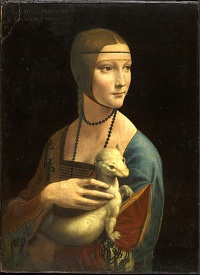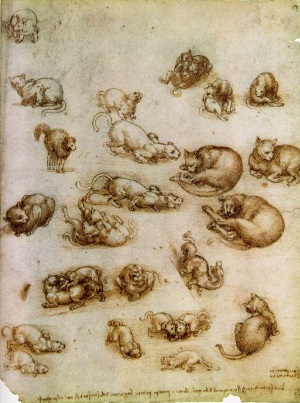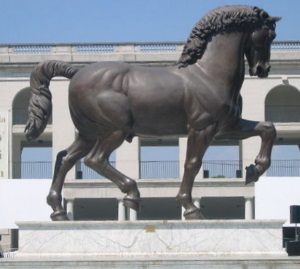
Leonardo da Vinci was born in 1492 at a Tuscan farmhouse in Anchiano, Italy, near the town of Vinci where he spent most of his childhood. He was the son of Ser Piero and a girl called Caterina who worked for him. After Leonardo was born, the father and mother did not remain together. Only recently have details of Leonardo's birth mother come to light.
In 2002, Alessandro Vezzosi, Director of the Leonardo da Vinci Museum in Vinci, Italy, told the press they had found substantial proof Leonardo's mother was a slave girl and not a peasant girl, as previously believed. Vezzosi went on to report that Leonardo's father was a craftsman who owned a Middle-Eastern female slave named Caterina. And, according to their discovery, a few months after Caterina gave birth to Leonardo, she was married off to one of the workers.
Leonardo lived in Anchiana and in Vinci until he was eight years old. Afterward, he moved to Florence with his father. When Leonardo was 14, he became an apprentice under the famed sculptor and painter Andrea del Verrocchio in Florence. In that period, Verrocchio was the leading Florentine artist. By the time Leonardo was between 21 and 23 years old, he had become a very skilled painter.
Verrocchio permitted Leonardo to help with an important painting, The Baptism of Christ (Uffizi Gallery, Florence). Leonardo painted the background and the kneeling angel. It is said that when Verrocchio saw that Leonardo could paint better than anyone he had ever seen, including himself, he gave up painting for good. Verrocchio decided he would concentrate on sculpture.
Leonardo da Vinci was said to have a great love for animals, and his journals further illustrates this. He was a vegetarian, at least in the latter part of his life (we don't have definite proof that he was a strict vegetarian in his early life). He wrote, "The time will come when men such as I will look upon the murder of animals as they now look on the murder of men." He also remarked, "The smallest feline is a masterpiece."
In the 1480s, Leonardo painted Lady With The Ermine. The Lady in the painting is Cecilia Gallerani, the 17-year-old mistress of Ludovico Sforza, Duke of Milan. She carries an ermine for three reasons. First, for the Duke of Milan, having been appointed to the Order of the Ermine by Ferdinand I of Naples, the ermine was the symbol of heraldry on his coat of arms. Second, the ermine was considered to be a symbol of virtue and purity. And finally, it was a play on Cecilia Gallerani's name since the Greek name for ermine is "galee".
In Leonardo's notebooks, he wrote that the ermine eats every other day. Most likely the ermine, an animal related to the sable and weasel, stayed in the studio while the painting was being completed. In the Renaissance period, soft-hair paint brushes were made of ermine tail tips. Brushes were also made from squirrel fur and fastened into goose or hen feathers - another reason the ermine might have been at home in the studio.

Leonardo da Vinci included cats in many of his sketches. On one sheet of animal sketches in his notebook, the artist portrayed more than twenty cats, and one dragon. He drew cats in different poses, alone, with other cats, and being cuddled and held. His sketches are lively and reveal the solemn affection he had for felines.
Throughout the mid to late 1470s, Leonardo worked on a series of different studies relating to the theme of the Madonna and the Christ Child, holding a cat. It was originally thought that no paintings existed beyond his initial studies for these paintings. Recently; however, Madonna with the Cat, which is in the collection of industrialist Carlo Noya in Savona, Italy, was discovered to be a painting by none other than Leonardo. The painting is based on a legend about a cat being born at the same moment as the baby Jesus.
Other sketches for paintings that feature animals and are based on a legend or myth is that of Leda and the Swan. Although no actual paintings exist, there are countless drawings. The story is that Leda was seduced by the God Zeus in the form of a swan and bore two eggs, which resulted in the creation of Helen of Troy with Clytemnestra, and Castor with Pollux.
Although there are countless studies and sketches made by Leonardo, only 13 or 14 actual paintings exist today. One of these is Madonna and Child with St. Anne, painted from 1508 to 1510. The figures depicted all relate to one another, and the baby Jesus is shown tightly holding a little lamb. Da Vinci painted the lamb with sensitivity and detail. The lamb is symbolic of Jesus Christ's sacrificial death for mankind. Leonardo's animal subjects are based on reality and are filled with vitality.
Leonardo is known to have kept horses, along with dogs, cats and other animals. Although numerous animal studies are found throughout Leonardo's drawings, his most frequent animal sketches are of horses. His renderings are extremely detailed and life-like. He infused his renditions of animals with nobility - a characteristic that stemmed from his deep love and respect for the animals he sketched and painted.
In the mid 1480s, Leonardo moved from Florence to Milan. At that time, Milan was one of the most powerful city-states in Northern Italy. And, it's Duke, Ludovico Sforza, commissioned Leonardo to make a horse like no other to honor the Duke's father, Francesco Sforzo. It was to be a massive, bronze-cast statue - the largest statue ever built, standing 24 feet high.
Leonardo made a great number of preparatory drawings for his Sforza Horse. His notebooks are filled with proportional studies of horses. There are detailed diagrams of the anatomy of horses, along with notes on how to cast it, and it would weigh 80 tons once complete! Leonardo made the clay model to scale, but the bronze horse was not to be.
In 1499, the French army threatened an attack. The metal intended for the Sforza Horse would be needed to make canons. Leonardo left Milan before the French Army marched on the city. Seeing the massive clay horse, the French soldiers could not resist using it for target practice.Thereafter it was reduced to rubble. Leonardo became despondent and at the same time, vowed to one day see his horse completely built.
Much has been written throughout history about the "Horse that Never Was". Five hundred years after the destruction of the clay model, based on the notes and sketches of Leonardo, the 24-foot bronze horse was cast. In fact, two full-scale statues were completed. One stands in Michigan, while the other was given as a gift to the City of Milan.

United Airline Pilot Charles Dent made it happen. Upon seeing the original sketches that had been rediscovered in Spain, he started the process of raising the necessary funds to build the full-scale, bronze horse. His plan was to give it as a gift to the Italians from the Americans. Being something of a sculptor himself, he built a clay model of the horse to Leonardo's specifications. And, although Charles Dent died in 1994, his dream lived on and over four-million dollars was raised.
On September 10th, 1999, exactly 500 years after the French destroyed Leonardo's clay model, the bronze statue was unveiled in Milan. On October 7th, 1999, a second casting of the horse was unveiled in Grand Rapids, Michigan. This second horse is known as the American Horse.
Along with his studies of mammals, Leonardo made hundreds of bird sketches. In the medieval publication Lives of Artists, Giorgio Vasari tells how Leonardo would go to the markets and buy caged birds, and then open their cages, giving them back their freedom.
Leonardo studied the motion of their wings in flight as well as their anatomy and physiology. He wrote down and illustrated his own theories on the flight of birds and was inspired to make several sketches of mechanical flying machines. He wrote a treatise called Codex on The Flight of Birds in which he made diagrams of a helical wing, beating wings, a parachute, and bat wings.
Later he realized the problems with human-powered propulsion and began making notes and diagrams of gliders. He also designed a machine based on a helical screw that was 32 or 33 feet in diameter. It was supposed to lift off and fly as the blade rotated, resembling a modern-day helicopter.
Leonardo's passionate interest in studying animals was unique for his time. He studied and observed animals, and sketched and painted them with grace and realism. Other Renaissance artists like Michelangelo (1475-1564) and Raphael (1483-1520), who focused more on the humanity and divinity in art, did not include animals in their works to the extent as Leonardo did. Without neglecting the Divine in Humanity, Leonardo above all other Renaissance artists, elevated all of nature and made it part of the Divine.
